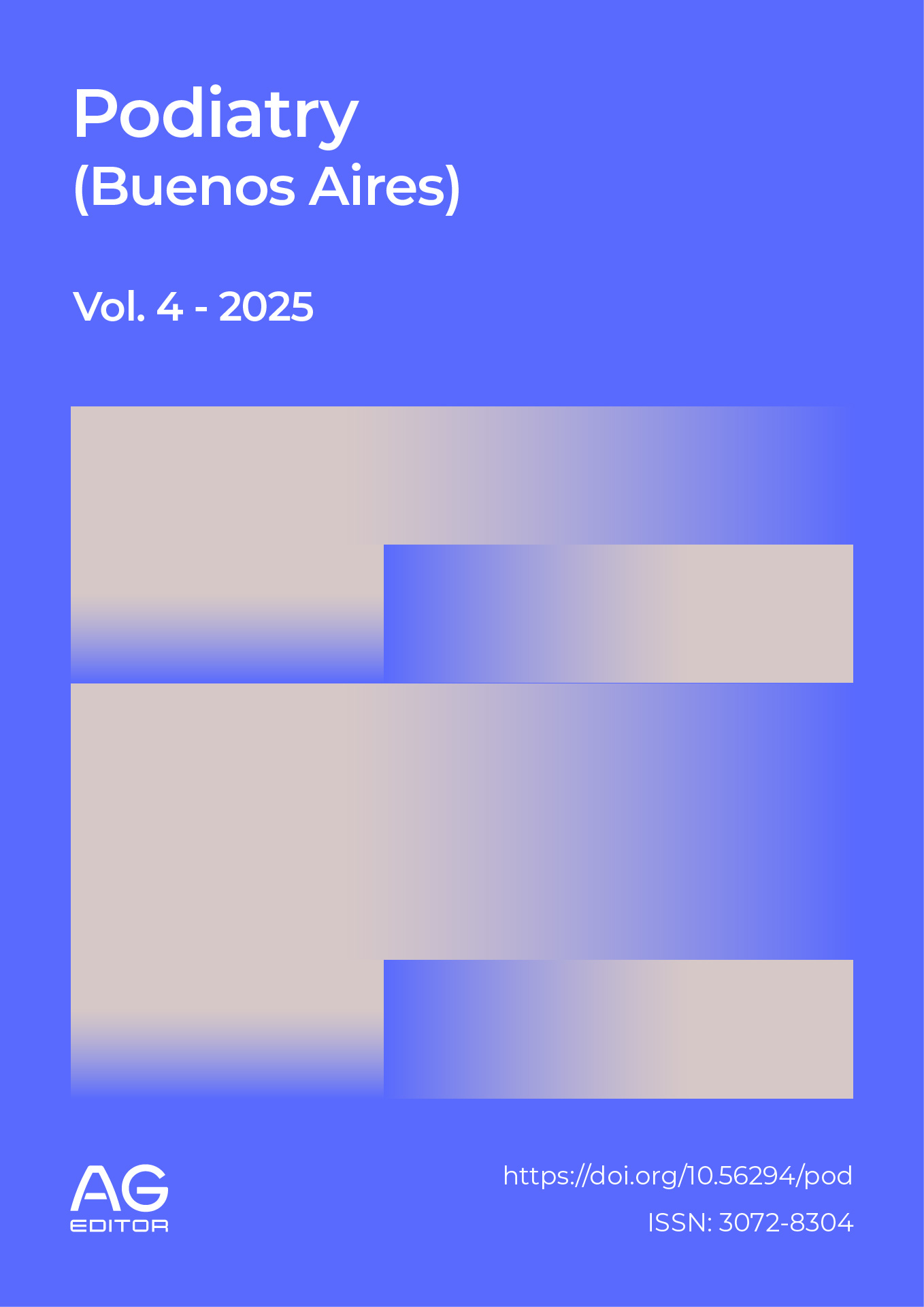Trends in the use of artificial intelligence in the treatment of diabetic foot
DOI:
https://doi.org/10.56294/pod2025152Keywords:
Diabetic Foot Ulcer, Diabetes Mellitus, Artificial Intelligence, Machine LearningAbstract
Introduction: Diabetes mellitus is a chronic disease with high incidence and prevalence worldwide, whose complications negatively affect the patient's quality of life. The incorporation of artificial intelligence in diabetic foot care shows potential for early detection and better decision-making.
Objective: to describe trends in the use of artificial intelligence in the management of diabetic foot.
Method: a search for information was conducted in the Scopus and SciELO databases. A search strategy using keywords and Boolean operators was employed.
Development: Artificial intelligence is revolutionizing healthcare through early detection and prevention of ulcers. Through predictive models, image analysis, and remote monitoring, it personalizes treatments and standardizes evaluations, resulting in more effective and cost-effective interventions for the system.
Conclusions: Artificial intelligence is a valuable tool in the management of diabetic foot, initiating a paradigm shift from an ulcer-centered model to a comprehensive, proactive, and predictive approach. This change is based on key advances: the enhancement and objectification of clinical diagnosis, the capacity for continuous, real-time monitoring, the anticipation of serious complications, and the democratization of care and patient empowerment.
References
1. Diabetes [Internet]. [citado 15 de julio de 2025]. Disponible en: https://www.who.int/health-topics/diabetes
2. Bandyk DF. The diabetic foot: Pathophysiology, evaluation, and treatment. Seminars in Vascular Surgery [Internet]. junio de 2018 [citado 15 de julio de 2025];31(2-4):43-8. Disponible en: https://linkinghub.elsevier.com/retrieve/pii/S0895796719300110
3. Pérez GAJ. Benefits and challenges of using AI in heritage education. EthAIca [Internet]. 30 de diciembre de 2024 [citado 15 de julio de 2025];3:102-102. Disponible en: https://ai.ageditor.ar/index.php/ai/article/view/102
4. Hernández-Lugo M de la C. Artificial Intelligence as a tool for analysis in Social Sciences: methods and applications. LatIA [Internet]. 23 de julio de 2024 [citado 15 de julio de 2025];2:11-11. Disponible en: https://latia.ageditor.uy/index.php/latia/article/view/11
5. Juárez GE, Gambino N. Professionalization and Artificial Intelligence in Family Businesses. EthAIca [Internet]. 30 de diciembre de 2024 [citado 15 de julio de 2025];3:139-139. Disponible en: https://ai.ageditor.ar/index.php/ai/article/view/139
6. Muthusundari S, Priyadharshii M, Preethi V, Priya K, Priyadharcini K. Smart watch for early heart attack detection and emergency assistance using IoT. LatIA [Internet]. 12 de agosto de 2024 [citado 15 de julio de 2025];2:109-109. Disponible en: https://latia.ageditor.uy/index.php/latia/article/view/109
7. Injante R, Julca M. Detection of diabetic retinopathy using artificial intelligence: an exploratory systematic review. LatIA [Internet]. 2 de septiembre de 2024 [citado 15 de julio de 2025];2:112-112. Disponible en: https://latia.ageditor.uy/index.php/latia/article/view/112
8. Cassidy B, Hoon Yap M, Pappachan JM, Ahmad N, Haycocks S, O’Shea C, et al. Artificial intelligence for automated detection of diabetic foot ulcers: A real-world proof-of-concept clinical evaluation. Diabetes Research and Clinical Practice [Internet]. 1 de noviembre de 2023 [citado 15 de julio de 2025];205:110951. Disponible en: https://www.sciencedirect.com/science/article/pii/S0168822723007143
9. Dhankhar S, Garg N, Chauhan S, Saini M. Role of Artificial Intelligence in Diabetic Wound Screening and Early Detection. Current Biotechnology [Internet]. 1 de junio de 2024 [citado 15 de julio de 2025];13(2):93-106. Disponible en: https://www.benthamdirect.com/content/journals/cbiot/10.2174/0122115501303253240408072559
10. Artificial intelligence of arterial Doppler waveforms to predict major adverse outcomes among patients with diabetes mellitus. Journal of Vascular Surgery [Internet]. 1 de julio de 2024 [citado 15 de julio de 2025];80(1):251-259.e3. Disponible en: https://www.sciencedirect.com/science/article/pii/S0741521424004014
11. Recognition of ischaemia and infection in diabetic foot ulcers: Dataset and techniques. Computers in Biology and Medicine [Internet]. 1 de febrero de 2020 [citado 15 de julio de 2025];117:103616. Disponible en: https://www.sciencedirect.com/science/article/pii/S0010482520300160
12. Khandakar A, Chowdhury MEH, Reaz MBI, Ali SHM, Kiranyaz S, Rahman T, et al. A Novel Machine Learning Approach for Severity Classification of Diabetic Foot Complications Using Thermogram Images. Sensors [Internet]. enero de 2022 [citado 15 de julio de 2025];22(11):4249. Disponible en: https://www.mdpi.com/1424-8220/22/11/4249
13. Khandakar A, Chowdhury MEH, Reaz MBI, Ali SHM, Abbas TO, Alam T, et al. Thermal Change Index-Based Diabetic Foot Thermogram Image Classification Using Machine Learning Techniques. Sensors [Internet]. enero de 2022 [citado 15 de julio de 2025];22(5):1793. Disponible en: https://www.mdpi.com/1424-8220/22/5/1793
14. Mining peripheral arterial disease cases from narrative clinical notes using natural language processing. Journal of Vascular Surgery [Internet]. 1 de junio de 2017 [citado 15 de julio de 2025];65(6):1753-61. Disponible en: https://www.sciencedirect.com/science/article/pii/S0741521416318444
15. Tulloch J, Zamani R, Akrami M. Machine Learning in the Prevention, Diagnosis and Management of Diabetic Foot Ulcers: A Systematic Review. IEEE Access [Internet]. 2020 [citado 15 de julio de 2025];8:198977-9000. Disponible en: https://ieeexplore.ieee.org/abstract/document/9246496
16. Natural language processing of clinical notes for identification of critical limb ischemia. International Journal of Medical Informatics [Internet]. 1 de marzo de 2018 [citado 15 de julio de 2025];111:83-9. Disponible en: https://www.sciencedirect.com/science/article/pii/S1386505617304756
17. Xie P, Li Y, Deng B, Du C, Rui S, Deng W, et al. An explainable machine learning model for predicting in-hospital amputation rate of patients with diabetic foot ulcer. International Wound Journal [Internet]. 2022 [citado 15 de julio de 2025];19(4):910-8. Disponible en: https://onlinelibrary.wiley.com/doi/abs/10.1111/iwj.13691
18. Identifying patterns in multiple biomarkers to diagnose diabetic foot using an explainable genetic programming-based approach. Future Generation Computer Systems [Internet]. 1 de marzo de 2023 [citado 15 de julio de 2025];140:138-50. Disponible en: https://www.sciencedirect.com/science/article/abs/pii/S0167739X2200334X
19. Toofanee MSA, Dowlut S, Hamroun M, Tamine K, Petit V, Duong AK, et al. DFU-SIAM a Novel Diabetic Foot Ulcer Classification With Deep Learning. IEEE Access [Internet]. 2023 [citado 15 de julio de 2025];11:98315-32. Disponible en: https://ieeexplore.ieee.org/abstract/document/10242064
20. Kaselimi M, Protopapadakis E, Doulamis A, Doulamis N. A review of non-invasive sensors and artificial intelligence models for diabetic foot monitoring. Front Physiol [Internet]. 21 de octubre de 2022 [citado 15 de julio de 2025];13. Disponible en: https://www.frontiersin.org/journals/physiology/articles/10.3389/fphys.2022.924546/full
21. Chemello G, Salvatori B, Morettini M, Tura A. Artificial Intelligence Methodologies Applied to Technologies for Screening, Diagnosis and Care of the Diabetic Foot: A Narrative Review. Biosensors [Internet]. noviembre de 2022 [citado 15 de julio de 2025];12(11):985. Disponible en: https://www.mdpi.com/2079-6374/12/11/985
22. Pappachan JM, Cassidy B, Fernandez CJ, Chandrabalan V, Yap MH. The role of artificial intelligence technology in the care of diabetic foot ulcers: the past, the present, and the future. World J Diabetes [Internet]. 15 de diciembre de 2022 [citado 15 de julio de 2025];13(12):1131-9. Disponible en: https://www.ncbi.nlm.nih.gov/pmc/articles/PMC9791570/
23. Chan KS, Chan YM, Tan AHM, Liang S, Cho YT, Hong Q, et al. Clinical validation of an artificial intelligence-enabled wound imaging mobile application in diabetic foot ulcers. International Wound Journal [Internet]. 2022 [citado 15 de julio de 2025];19(1):114-24. Disponible en: https://onlinelibrary.wiley.com/doi/abs/10.1111/iwj.13603
Published
Issue
Section
License
Copyright (c) 2025 Barbarito Malagón Silva (Author)

This work is licensed under a Creative Commons Attribution 4.0 International License.
The article is distributed under the Creative Commons Attribution 4.0 License. Unless otherwise stated, associated published material is distributed under the same licence.





